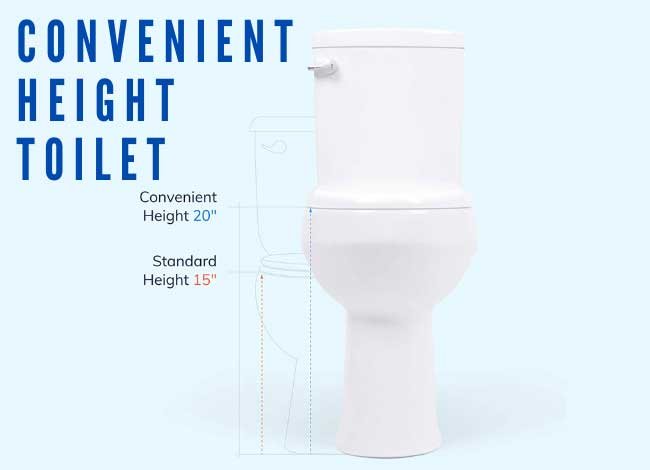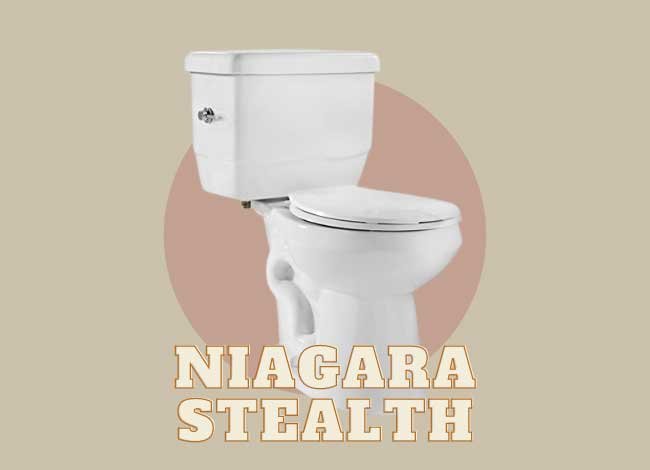Last Updated on December 26, 2024
Should I buy a 1.28 GPF toilet or a 1.6 GPF toilet? This is one of the questions that linger on buyers’ minds when looking for an efficient and reliable best toilet for their bathroom. With water becoming scarce, toilet manufacturers have resorted to creating water-efficient toilets in a bid to reduce the rate of water used during flushing.
For 1.28 GPF Toilets:
Daily Water Usage: 1.28 GPF * 3 Members * 4 Times= 15.36 GPF
Monthly Water Usage: 15.36 GPF*30= 460.8 GPF
Yearly Water Usage: 460.8 GPF*12= 5,530 GPF
Cost of GPF: $0.018
Annual Water Bill: $0.018*5,530 GPF= $100 (Average)
For 1.6 GPF Toilets:
Daily Water Usage: 1.6 GPF * 3 Members * 4 Times= 19.2 GPF
Monthly Water Usage: 19.2 GPF*30= 576 GPF
Yearly Water Usage: 576 GPF*12= 6,912 GPF
Cost of GPF: $0.018
Annual Water Bill: $0.018*6,912 GPF= $125 (Average)
Related: Best Flushing Toilet Review [Most Popular 15 Toilets list]
The toilet uses a whopping 30% of water among the various home fixtures. This is high when compared to other bathroom fixtures. As a result, the federal government developed a law requiring all toilets to be installed to use 1.6 GPF or less. Today, toilets that are installed in the USA must consume 1.6 GPF or less. In some states like California and Colorado, the water usage rate is even lower at 1.28 GPF.
1.28 Vs. 1.6 GPF Toilets Feature Comparison Chart
Here is a full comparison of the 1.28 GPF and 1.6 GPF toilets:
| Feature | 1.28 GPF Toilets | 1.6 GPF Toilets |
|---|---|---|
| Water Consumption: | 1.28 gallons per flush (GPF) | 1.6 gallons per flush (GPF) |
| Water Savings: | 20% more water-efficient | Less water-efficient |
| Environmental Impact: | Lower | Higher |
| Federal Standards Compliance: | Compliant with all U.S. federal standards | Compliant with older U.S. federal standards |
| Performance: | Powerful flush with less water | Powerful flush but uses more water |
| Rebates and Incentives: | Eligible for most water-saving rebates | Less likely to be eligible for rebates |
| Cost: | Generally more expensive upfront | Generally less expensive upfront |
| Long-term Cost Savings: | Lower water bills due to water savings | Higher water bills due to more water usage |
| Availability: | Widely available | Widely available |
| Maintenance and Clogging: | Less likely to clog due to improved technology | More likely to clog compared to 1.28 GPF toilets |
| Ease of Installation: | Similar installation process | Similar installation process |
| Powerful Flush: | Yes | No |
| 1 Flush Enough? | 1 Flush is Enough | Some time may need two flush |
| Sound: | Quiet | Quieter |
| Bowl: | Larger | Smaller |
| Space Saving: | No | Yes |
| Laws: | A few USA States Don’t Allow | USA, all States Allow |
| Popularity: | Decreasing | Increasing |
| Bowl After Flush: | Marginally Cleaner | Clean |
| Price: |  Check Price Check Price |
 Check Price Check Price |
So, as you debate about which toilet to choose between the 1.28 GPF and 1.6 GPF, you should be aware of the country and state regulations on water usage.
1.28 GPF toilet pros & cons
With the improvement in technology, you should no longer worry about your toilet failing to be effective when it comes to clear waste. Toilet manufacturers have come up with advanced technologies that allow toilets to use less water but clear waste very efficiently. That’s what you get with most 1.28 GPF. These toilets help you to save water, and you may even get rebates in some states.
Related: Best Low Flow Toilets Reviews [10 Water-Saving Toilets]
Additionally, 1.28 GPF toilets meet the EPA WaterSense guideline; thus, they can be installed anywhere in the country.
Pros:
- It is EPA WaterSense certified
- It saves water as it uses less than 1.28 GPF
- 1.28 gpf toilet is compact with a space-saving design
- It can be installed anywhere in the country
Cons:
- Users may have to flush more than once
- The flush is not very powerful
1.6 GPF toilet pros & cons
Before 1.28 GPF toilets became popular, 1.6 GPF toilets were the real deal. But at the moment, 1.28 GPF is trending, and the sales for 1.6 GPF toilets are slowly coming down. However, some people still prefer them over 1.28 GPF toilets as they have a more powerful flush.
Pros:
- It has a powerful flush
- Normally flushes quietly
- It conserves water as it uses 1.6 GPF
- No need to flush twice as it is effective
Cons:
- It is not EPA WaterSense certified
- The toilet cannot be installed in all states in the country
- Similarities and differences between 1.28 GPF and 1.6 GPF toilets
Differences Between 1.6 and 1.28 GPF Toilets
Summary of content
Flushing efficiency
Many people use the toilet even without considering how much water they push down the drain. Over the years, the amount of water used to flush the toilet has reduced. In the 1980s, toilets used more than 7 GPF; then, it came down to 3.5 GPF. In 1994, the Energy Policy Act was implemented, and it required toilets to use less than 1.6 GPF. That amount is even lower today as they are pushing for 1.28 GPF.
However, there is a difference in flushing efficiency between the 1.28 GPF and 1.6 GPF toilets. Toilets that use 1.6 GPF are more powerful and typically don’t require the user to flush the toilet twice. On the other hand, most of the 1.28 GPF toilets don’t feature a very powerful flush, but they are efficient in water usage.
Size of the toilet
Most 1.28 GPF toilets are usually compact with a smaller bowl when compared to 1.6 GPF toilets. So, if the size is important to you, you should consider selecting a 1.6 GPF unit.
Ease of maintenance
Maintaining 1.28 GPF toilets might be challenging as most of them tend to clog. This is not the case with most 1.6 GPF toilets. So, find out if the toilet you’re buying has an efficient flushing system or not. Also, such toilets will tend to leave behind marks that can force you to clean the toilet after every use.
EPA WaterSense certified
When it comes to saving water, the 1.28 gallons per flush toilet is the best option, hands down. That’s why it is referred to as a high-water-efficiency toilet. In some states like Georgia, you will get rebates for installing this type of toilet.
However, states like California, Texas, and Colorado require all toilets to be installed to be high-efficiency. This is because water is scarce in these states.
Price
Even though 1.6 GPF toilets feature a more powerful flushing system, the 1.28 GPF toilet is more expensive. It is worth the price when you look at it from a different perspective. After all, you will save water and receive a lower water bill. Also, you may get rebates in some states for installing it.
What is the alternative of 1.28 and 1.6 GPF Toilets?
Toilets with dual-flush technology, offering 1.28 and 1.6 gallons per flush (GPF), are an innovative solution for water conservation. These toilets feature two buttons or a handle mechanism, allowing users to choose a lower-volume flush for liquid waste and a higher-volume flush for solid waste. The 1.28 GPF option significantly reduces water usage compared to traditional toilets, making it eco-friendly. The 1.6 GPF option, though slightly higher in water usage, still offers efficiency for tougher jobs. This dual-flush design conserves water and lowers utility bills, making it a cost-effective and environmentally responsible choice for households and businesses.
Which is better? 1.6 or 1.28 GPF?
If you want to conserve water and get rebates, then you’re better off with the 1.28 GPF toilet. But if you want an efficient flushing system, then you should consider picking the 1.6 GPF toilet. Both of these toilets will help you save water and perform efficiently.
For those who live in California, Colorado, and Texas, you have no choice but to choose the 1.28 GPF toilets. I wish you all the best as you try to save water and install a comfortable and reliable toilet in your bathroom.
Frequently Asked Questions
Question: Are 1.28 GPF toilets as effective as 1.6 GPF toilets in flushing?
Answer: Yes, modern 1.28 GPF toilets are designed to be just as effective in flushing waste as 1.6 GPF toilets, often using improved flushing technology.
Question: Can I save money by using a 1.28 GPF toilet?
Answer: Yes, 1.28 GPF toilets can reduce water usage, leading to lower water bills and potential savings over time.
Question: Do 1.28 GPF toilets require more frequent maintenance?
Answer: Not necessarily. Both 1.28 GPF and 1.6 GPF toilets require similar maintenance, depending on usage and water quality.
Question: Is there a significant difference in environmental impact between the two?
Answer: Yes, 1.28 GPF toilets are more environmentally friendly as they conserve more water, reducing the overall water consumption.
Question: Will a 1.28 GPF toilet fit in the same space as a 1.6 GPF toilet?
Answer: Generally, yes. They are designed to fit standard toilet spaces, but it is always good to check specific dimensions.
Question: Are 1.28 GPF toilets more expensive than 1.6 GPF toilets?
Answer: The price can vary based on brand and features, but generally, the cost is comparable, and water savings can offset any initial difference.
Question: Can I replace a 1.6 GPF toilet with a 1.28 GPF model without modifying the plumbing?
Answer: Yes, in most cases, 1.28 GPF toilets can be installed without any major plumbing modifications.
Question: Do 1.28 GPF toilets clog more easily than 1.6 GPF toilets?
Answer: No, they are not more prone to clogging. Their design compensates for the lower water volume to maintain effective flushing.
Question: What are the benefits of upgrading to a 1.28 GPF toilet from a 1.6 GPF?
Answer: Benefits include reduced water usage, potential cost savings, and a positive environmental impact.
Question: Can I get rebates or incentives for installing a 1.28 GPF toilet?
Answer: Many regions offer rebates or incentives for installing water-efficient toilets. Check with your local water authority.
Question: How do I know if a toilet is 1.28 GPF or 1.6 GPF?
Answer: The GPF rating is usually indicated on the toilet or in its product documentation.
Hi, I am Jose S. Franz. Currently, I am working as a professional plumber, and our team offers various plumbing services at an affordable price. After my college education, I completed a vocational certification course in plumbing systems and worked with several construction companies. Since then, I have fixed lots of different toilet models, from older to the latest versions. So I have more than 22 years of experience installing plumbing systems and toilets in both residential and commercial buildings.


 Check Today’s Price On Amazon
Check Today’s Price On Amazon Check Today’s Price On Amazon
Check Today’s Price On Amazon
